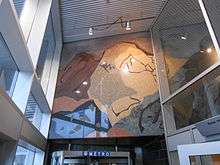Françoise Sullivan
| Françoise Sullivan CM CQ | |
|---|---|
| Born |
June 10, 1925 Montreal |
| Nationality | Canadian |
| Education | Hochelaga Convent |
| Alma mater | École des beaux-arts de Montréal |
| Style | modern dance |
| Movement | Les Automatistes |
Françoise Sullivan, CM CQ (born June 10, 1925 in Montreal) is a Canadian painter, sculptor, dancer and choreographer.
Biography
Early life
Françoise Sullivan grew up in Montreal, the youngest child and only girl in a middle-class family with four boys. Her father was a lawyer who worked as the Deputy Minister of the Federal Post Office Department. He enjoyed poetry and both he and her mother encouraged her early interest in the arts by enrolling her in dance, theatre, and painting lessons.[1][2]
Education and career
Sullivan studied classical dance with Gérald Crevier from 1934 to 1945. She also took courses in visual arts, studying at Hochelaga Convent in 1939 and attending the École des beaux-arts de Montréal from 1940 to 1944. Her early paintings were influenced by Fauvism and Cubism. In 1941 she came into contact with the Québecois painter Paul-Émile Borduas and members of the group Les Automatistes. Her friendship with Bourduas and the group influenced her paintings and performances in the following years. In 1948, Sullivan signed Les Automatistes' Refus Global manifesto, which included her essay La danse et l'espoir (Dance and Hope).[2]
From 1945 to 1947, Sullivan lived in New York where she studied modern dance with Franziska Boas, the daughter of anthropologist Franz Boas. She also studied briefly with Martha Graham and Louis Horst. After returning to Montreal in 1947 she continued choreographing modern dance. In 1948, accompanied by Jean-Paul Riopelle and Maurice Perron, Sullivan performed Danse dans la neige (Dance in the Snow) outside Mont-St-Hilaire, Québec. Perron and Riopelle both documented the performance, however, only Perron's photographs remain as Riopelle's film footage was later lost. Like other members of Les Automatistes Sullivan was interested in 'psychic automatism' and Danse dans la neige was the second in a series of performances in which Sullivan improvised gestural movements to explore the seasons. Danse dans la neige is considered one of the most significant pieces of performance art in Canadian art history. In 2007 Sullivan reworked her first two performances Summer and Danse dans la neige and completed two more choreographed dances which were filmed by Mario Côté to create Les Saisons Sullivan.[1][3]
On April 3, 1948 Sullivan performed with her dance partner, Jeanne Renaud, at Ross House on the McGill University campus in Montréal. Their collaborative performance featured choreographed and improvised movements, accompanied by a poetry reading by Claude Gauvreau. This event is considered a significant moment in the history of modern dance in Québec.[3][4]
In 1949, Sullivan married the painter Paterson Ewen. Between 1952 and 1956, she worked as a dancer and choreographer for CBC television. In the late 1950s, she turned to sculpture under the guidance of Armand Vaillancourt and learned welding at École des arts et métiers in Lachine, Québec. In 1960, she took a three-month course in sculpture with Louis Archambault at the École des beaux-arts de Montréal where she learned how to work with wood, iron, and plaster. In the late 1960s, Sullivan and Ewen experimented with the plexiglass. In 1976, they collaborated with the sculptor David Moore.

During the 1980s, Sullivan returned to painting and between 1982–1994 produced several series, which are regarded as the culmination of her work in this medium. In 1997, she completed Montagnes (Mountains), a granite wall located in the main lobby of President Kennedy Pavilion of Université du Québec à Montréal. In 2000, the university bestowed upon her an honorary doctorate. Since 1997, Sullivan has taught painting at Concordia University.[5] In 2001, she was appointed a Member of the Order of Canada and the Musée d'art contemporain de Montréal held a retrospective of her work.[6]
Honours
- 1963 – Prix du Québec, Sculpture
- 1983 – Victor Martyn Lynch-Staunton Award
- 1987 – Prix Paul-Émile-Borduas
- 2000 – honorary doctorate from Université du Québec à Montréal
- 2001 – Member of Order of Canada
- 2002 – Knight of the National Order of Quebec
References
- 1 2 Enright, Robert (May 2008). "A Woman for All Seasons: An Interview with Francoise Sullivan". Border Crossings.
- 1 2 "Canadian Women Artists History Initiative : Artist Database : Artists : SULLIVAN, Françoise". cwahi.concordia.ca. Retrieved 2016-03-08.
- 1 2 "Francoise Sullivan". Celebrating Women's Achievements. Collections Canada. 2003. Retrieved March 8, 2016.
- ↑ "Concerts With Francoise Sullivan". www.dcd.ca. Retrieved 2016-03-08.
- ↑ ccca.concordia.ca
- ↑ collectionscanada.gc.ca